While She Sleeps’ Sean Long: “I don’t want people holding this guitar and being scared to put it down. I want people to f**k it up!”
Sean Long discusses his new signature Charvel, explaining why its utilitarian build prepares it for the physicality of his sound, and how open tunings help him find fresh musical ideas

You can learn a lot about pro guitar players from the gear choices they make. Take Sean Long, guitarist for English metalcore stalwarts While She Sleeps. He has a new Charvel Pro-Mod San Dimas signature guitar, a high-performance take on a Stratocaster that pares the Superstrat design concept down to the essentials.
There’s no vibrato. No middle single-coil pickup. No tone knob. The shock of hi-vis yellow on the cover of his EMG 57 bridge humbucker, and on the Charvel headstock logo, is one of few aesthetic flourishes (the other, at least in in Long’s eyes, was maple fingerboard).
Long’s new signature whip’s high-gloss black finish eats the light. There are no fretmakers but Luminlay glow-in-the-dark side markers are on-hand for navigation. Locking tuners and the hardtail bridge? It’s built to play hard, and that’s the point.
When Long sits down at Fender’s London headquarters to explain these design choices, it all makes sense. It’s a guitar that leaves room for the performance, for thrashing it live, onstage. Long admits he doesn’t want it to be a guitar that looks or feels to precious to pick up and abuse. That would be missing the point.
There’s a physicality to While She Sleeps’ sound, and to their stage show. To jeopardise this with trivial accoutrements – on his guitar, on his pedalboard – would be folly. Indeed, when Long sits down to talk about this guitar, his philosophy with regards guitar playing, performance, living and writing as an artist becomes clear.
It’s all about writing. Sometimes breakfast gets in the way, he says. Intermittent fasting – which sounds very Steve Vai – was a tactic to focus the mind. “I’m sharper. I’m more edgy,” he explains. “I love eating for sure, but it turns into an inconvenience.”
Boxing helps, again speaking to the physicality in playing this style of music. Nightly, when on tour, but especially in the studio, this physicality is rendered in volume
Want all the hottest music and gear news, reviews, deals, features and more, direct to your inbox? Sign up here.
“Dude, I need it loud,” he says. “If I want to get into it, I need it loud. In my studio, when I’m writing a riff and I am into it, you wouldn’t believe how loud I play. It’s so fucking loud.”
“I need stage volume,” he continues. “I play with in-ears but we have monitors, too, whereas most people would use in-ears and then scrap the wedges. We have wedges… I’ll play, and I will pull my left ear [monitor] out so I can hear the real thing. They are a blessing and a curse, the in-ears. They make it sound sick and we’re tight as fuck. But you miss out on some of the ambience of the room, so I peel them out a little bit.”
I never realised how much that release onstage was doing for me mentally and physically
And to miss out on that would be a crime. Like every other touring musician, Long and While She Sleeps have missed out on that live experience. As Long sees it, it’s multi-sensory, a barrage of competing frequencies working in concert, and the performance, in all its unfiltered chaos, is ultimately a form of therapy to be undertaken with electric guitar in hand.
“I never realised how much I needed this band in terms of what we do,” he says. “We have this half-an-hour of insane intensity on tour every night. We’re only spending a little time at home. During this time, with all this taken away, we realised how therapeutic this time was when we play onstage. In terms of the physical aspect, I never realised how much that release onstage was doing for me mentally and physically.”

There is an inherent physicality to playing guitar, especially for your art form. And that physicality cannot be fully imagined into being. It’s funny you describe it as therapy, but it can also be a chore, a real challenge. That half-an-hour you might dread, even though you know you will be ecstatic once it happens.
“Absolutely, yeah! It’s the same principle as the gym. And it’s not just the playing. We do a lot of physical acts – moving around and jumping around – and the things we are singing about are quite passionate for us, so we are exerting a lot of anger and emotion that we really want to get out there. Even if we’ve had a cranky day, this is our opportunity to really blow up.
“This is something that interests me. I do a little bit of boxing as well, and any kind of martial artists – or most fighters – are incredibly nice people, and I think it goes the same way with the metal community and the heavier side of things. Everyone in the scene is so nice and calm, and relaxed, and I think it is because we have this – as a team and as a group – a huge outlet… That we take for granted! And maybe we aren’t conscious about.
“We have this huge angry outlet that we are all enjoying together and we seem to be happy people as a whole. And yet, a lot of the pop-culture, the pop and dance music seems to be where most of the violence is sometimes. It’s quite a weird paradox that I have seen and was made apparent to me in this break.”
How does it affect the act of writing? Where you have to imagine that energy into being.
“I always write. Writing is my primary objective in life and in the band. I love to write music regardless. Always, I am imagining. It never controls the way I write but it has to play a part. Because I can’t always do everything because it might ruin the live show.
“I manoeuvre my lead patterns in different ways while I am writing. I have the say, we get a say, in deciding how it is going to flow onstage; because it is important to me to perform onstage. I don’t want to be stood there playing leads all the time – which is a lot of what I do. I also like to have fun, and throw my guitar around, and to not play a solo.”

There has to be space for that, gaming out how it will be performed. Sometimes, with guitar, we are always talking about technique, theory, writing, but the performance has to have the same weighting.
“I think it is two sides of the same coin, but they are different aspects of being an artist. I think the live thing is just another entity in itself. You write the songs, but just the live version is… It’s two different experiences. Completely. For the listener and the performer.
“They come from the same place but they are just two different things. You can make so many mistakes live but the mistakes add all the coolness to it, and it’s real. And everyone knows it. That’s almost cliched by now. But it’s real. You don’t want it to be perfect, and that is the whole point.
This is something I have realised, and it’s really blown my mind. You get a guitar in tune as good as you can; it’s not never really, in tune in tune
“This is what interests me about music, actually, it’s the discordance between the notes as you are layering things up that creates those nice organic sounds. So it’s actually the negative discords on a subtle level that create the harmonic resonance that’s really exciting.
“And it is the same thing live, where you have all these discrepancies, and they are all bouncing around out of time, and it is all crazy, and it creates this whole beautiful thing. That is what interests me about music in general, this whole vibration aspect to it. Is it in tune? Is it not? It is never in tune!
“This is something I have realised, and it’s really blown my mind. You get a guitar in tune as good as you can; it’s not never really, in tune in tune. So it is the layering of these cents of out-of-tune things, all the way through to the drums, the layers, the synths, the vocals, nothing is really, really in tune. But it is that little phase between them all that creates something special. That should say something about life itself.”
There’s something reassuring about the imperfection. That’s a dynamic itself. Those dynamics are important to your sound.
“Well with these, you can choose if you want the dynamics or not, which is quite interesting. With a single-coil, it is all there. With this, I can choose whether to have it as a block of sound, which I never really do. But with my playing, I can control the dynamics with my wrist and the way I like the gain to come through.
“The way the gain is on these pickups is very good for a beginner guitarist as well because they can help you feel like it is really good but, if you want to get tighter, you can dial the gain back on your amp and get it with the pressure and your wrist.”
Make your technique do the heavylifting.
“That’s it.”
With my playing, I can control the dynamics with my wrist and the way I like the gain to come through
Your electric guitar pickups are not the most super-powered EMGs. They are a little more old-school. Have you always used the 57/66 pairing?
“No, I’ve promoted the 57/66 more than anything but I have recorded with 81s. My first album was with an 81. I love the pickups. They’re cool. That’s what let to the 57/66, because I messaged EMG and said, ‘Is there anything new I can try? Something a little more vintage, or something with a finer gain?’ Which I think these have.
“The gain on the 81, how I would describe it is like this [makes chopping motion] and this is almost fizzier, smoother, fizzier, so it lends itself to my leads, and the riffs are… [Laughs] It’s really hard to describe sound! But I just think it is finer. Like the frequencies are going a bit faster.”
Well, the EMG 81 you kind of associated with that breeze-block James Hetfield rhythm tone.
“Yeah, I’m a big fan of it. If I have a riff – a riffy riffy riff [hums riff]– I’ll pick up an 81 and i will record with it. We record with all sorts of pickups.”
I have been playing single-coils a lot and I am really enjoying it as an inspirational tool
It’s maturity, or not even that. You’ll use the same pickups then, suddenly, you’ll want something different. A different flavour. Your tastes develop.
“Well that’s it. You find out that you’ve been kidding yourself, adding things to make it easier for yourself – which I have done a lot of. A little bit more gain? Yes. Scooping the mids. A bit more treble. Get a boost on the end of it. All of these things are adding to the discrepancies in the sound but you’ve got to dial it back. The tone will shine just so much brighter.”
That’s the thing you learn when recording. You take things out and as if by magic it sounds bigger.
“That’s it. It’s less is more. I’ve always been like, ‘Yes! Turn your gain up to 10. Turn the bass up to 10.’ But you want to use as little gain as you can and let your wrist to the work.”
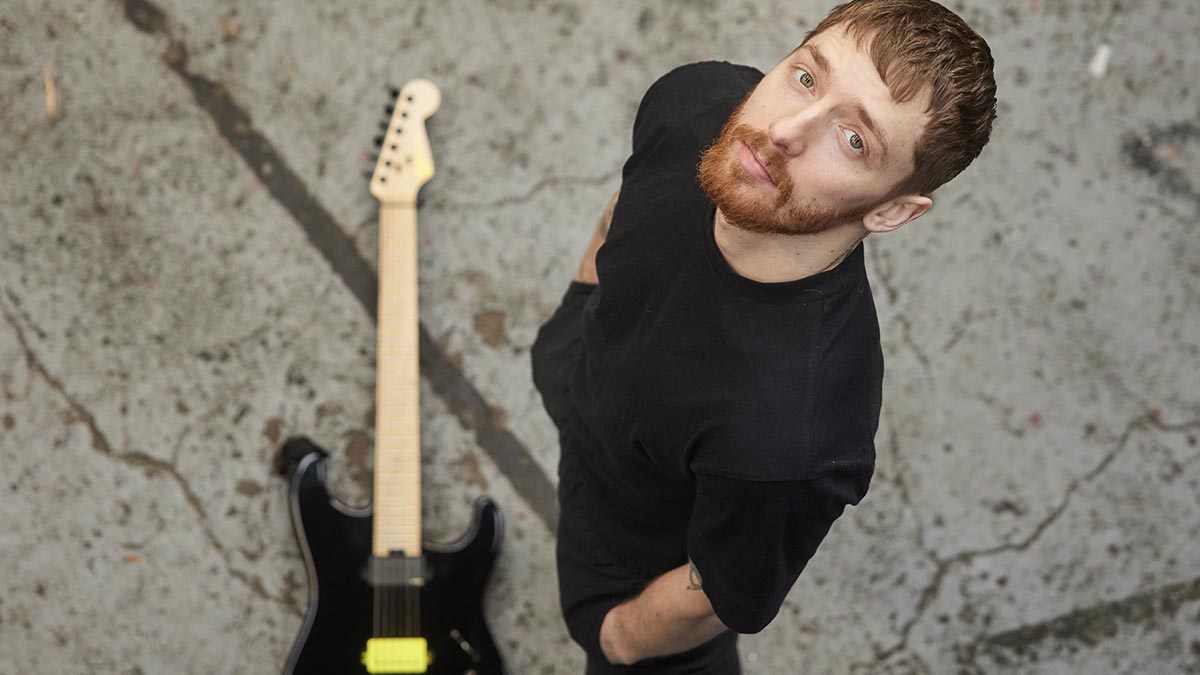
That then puts the responsibility for the good sound onto your playing and the musical ideas you had in the first place. And if the ideas are no good… But it is easy to overpower a mix, or a sound.
“I think it is easy to stay with the same thing forever. This [guitar] could have just had 81s on it. I was saying recently that I am actually getting really intrigued with single-coils. I have been playing single-coils a lot and I am really enjoying it as an inspirational tool. So never say never. I no longer never say never. I’ll try everything.”
Well you have a bass player who can add weight and width to it. So it you wanted the directness of the single-coil there are ways to work it in. Maybe go with a P-90 first.
“Well! I have asked EMG and they sent me their single-coil which is in a humbucker casing. I put it in my yellow signature Charvel and it is their version of a P-90 and, dude, you drive the gain on that thing and it is fucking incredible. So yeah, never say never.”
Also, that P-90 vibe speaks to the While She Sleeps punk influence.
“We have always recorded with single-coils. Every now and then we’ll put them in riffs and stuff. But I have never considered one as a route for me. I need my EMGs and the weight that comes with them. But then I have just opened a box up in my head.
“Maybe I could do a single-coil song, and like you said, it’s maturity. You block a lot of things out when you are just EMG, just metal, whatever. Then you think, ‘Well that sounds fucking sick.’ And you try it and you surprise yourself.”
What about your tunings?
“Well, I do Drop D. I do Drop C. I do Drop D but it’s an open tuning based around fret four. And then I do D-X, which is a tuning I made up.”
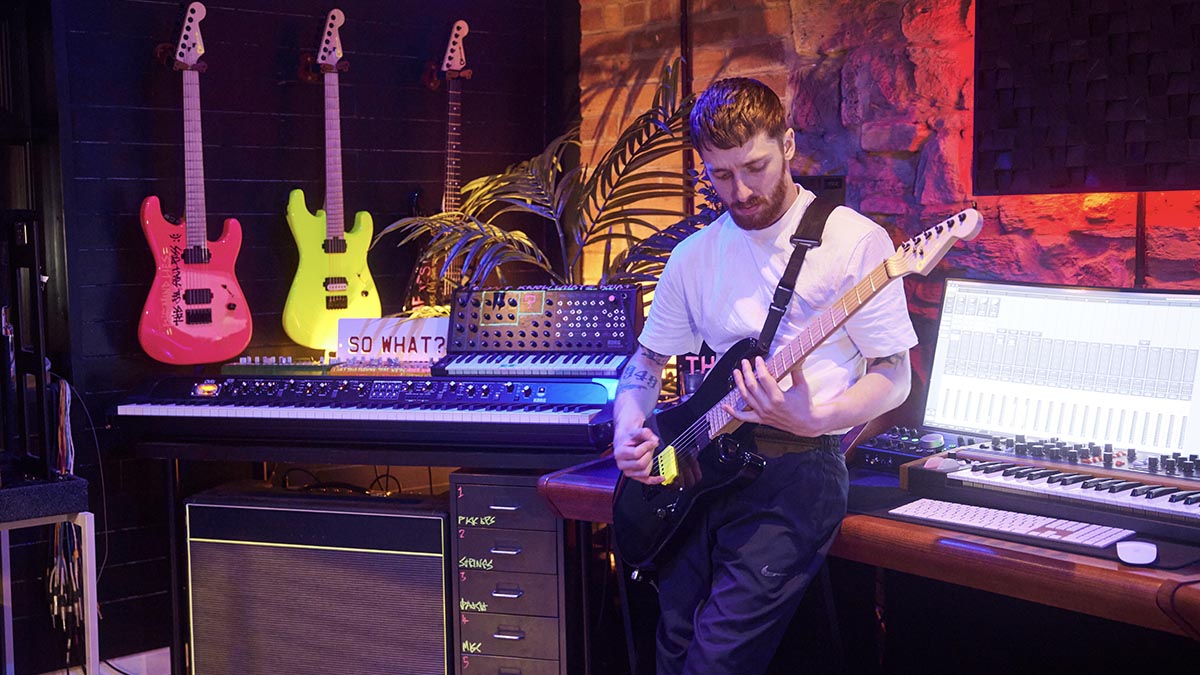
What’s DX?
“It is the open tuning based around fret four, and its D… I am not going to say it but I know the last three are F#, C and F#. So it is an open tuning and this is where some of my strange lead patterns come from. I’ve got a CZ, which I made up.
“This is the cool thing, I made these tunings up, but CZ is just a C open tuning but I made it up on my own. I didn’t know it was already C open. I called it C-Z. It can stay C-Z for me. So, I’ve got D-X, C-Z, Drop A, A#, Drop C.”
I’ve even drawn on my pickups before and people were losing it. Like, just f**kin’ relax, man! They think it’s going to dampen the tone? Well, maybe it does. It will be okay.”
That helps you hot-wire the patterns when you’re playing. We get too familiar with shapes and patterns on the fretboard.
“Dude, 100 per cent. And this is the same principle with the maple neck decision – it looks different. It inspires me when I look at it. It is something that is overlooked in the guitar world and I am trying to break through this weird stigma where all the specs need to be completely right and, sometimes, everybody disregards, ‘I like this because it looks good.’
“That’s important. You need to be inspired by how it looks aesthetically, and for me, I don’t get to look at this very often. It’s the brightness. I’ve only ever looked at dark woods, rosewood my whole life. Looking at this, it inspires me to write music.”
It is inherently psychological. Then you have the idea that the maple lends something to the tone.
“I think it does. I think it is a happy accident. I think there are always going to be tonal differences. There are too many variables; something is going to change the tone. Like I was saying earlier, I draw all over my cabs and paint them, and I would paint on the cones of the amps and – God! – everyone is freaking out online. ‘You’re ruining your tone!’ And all this shit. I’m like, ‘Guys, worry about something else. It will be fine.’
“I’ve even drawn on my pickups before and people were losing it. Like, just fuckin’ relax, man! They think it’s going to dampen the tone? Well, maybe it does. It will be okay.”
If you start getting precious and worrying about these details then an accident happens, and it will upset you and get under your skin.
“That’s right. Like, I am so invested in this guitar but I will still never glorify the instrument or anything else. I will fuck this shit up. I will fuck this up. But it is going to allow me to do it.”
When it says Charvel on the headstock it’s already given you permission to mess around with it. That’s what the brand was all about, doing weird stuff to existing designs, and then playing it hard.
“I don’t want people holding it and being scared to put it down. I don’t want that. I want people to fuck it up.”
It deepens the engagement with it. It’s not that expensive.
“This is the same as any other Charvel. People have the opportunity to get a really good Charvel for a grand. Take that opportunity.”
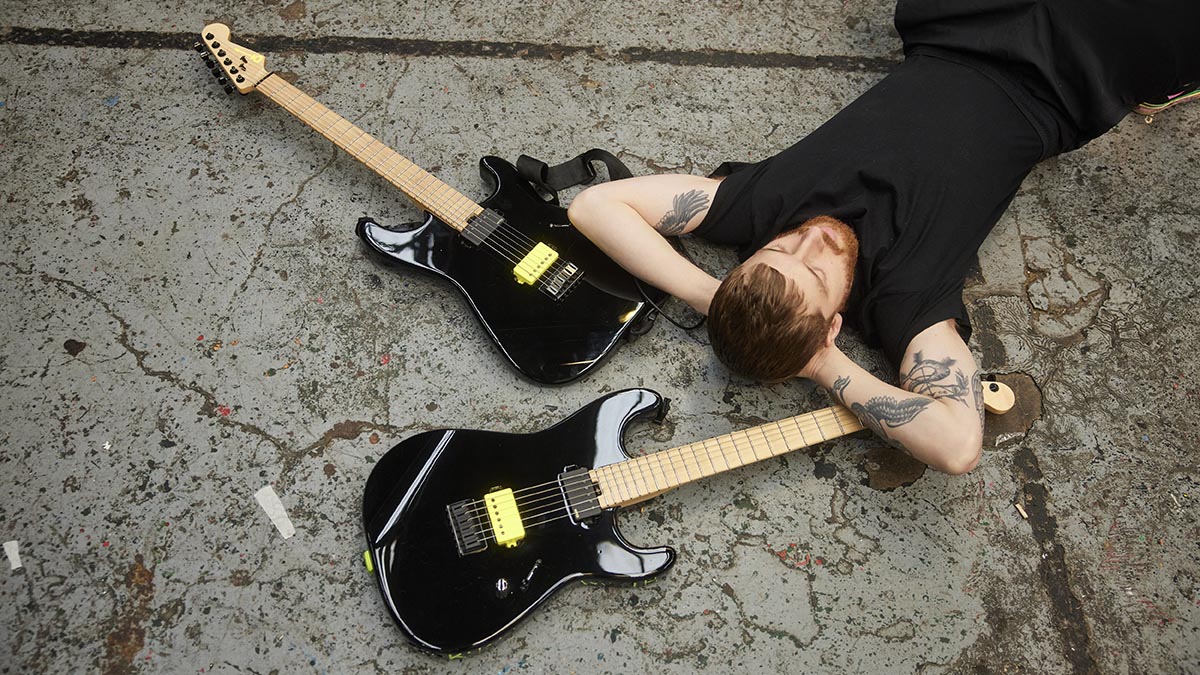
And you can hammer it. There’s no vibrato either…
“Maybe one day. I am not against that. I use it on the [whammy] pedal when I do all that stuff. I’ve never been a fan of Floyd Roses per se but the whammy bar I can definitely get behind.”
Well that’s another thing. The Floyd would be seen as the typical choice for the metal player but a 2-point tremolo would do a good job.
“I’ve always thought the Floyd Rose was to keep it in tune, essentially. Then I realised that, if you set the guitar up right, and you played it, it would stay in tune. You could legit do anything you want with it. And obviously it is there for the bending, and I understand that, but initially I saw it as, yeah, you get to lock it in and it stays in tune, but you’d be surprised at what I can do with this and it will not even budge. If you pull it in right, intonate it right, it will not budge.”
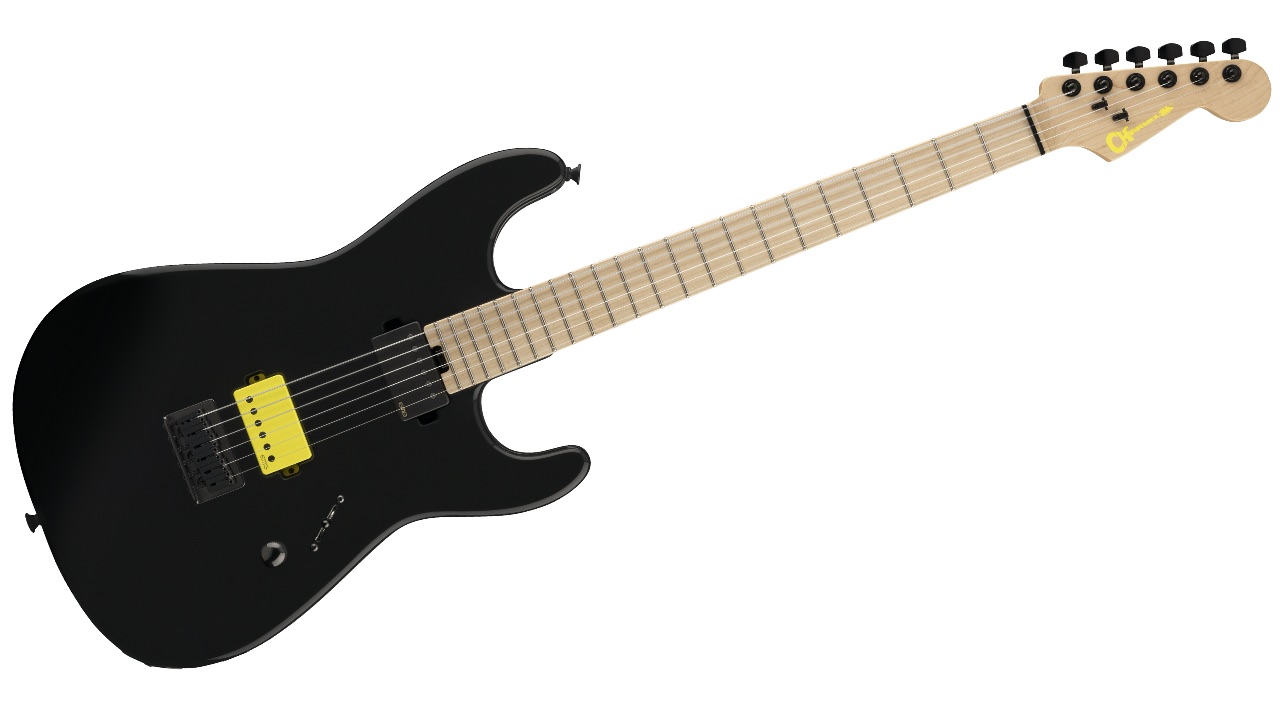
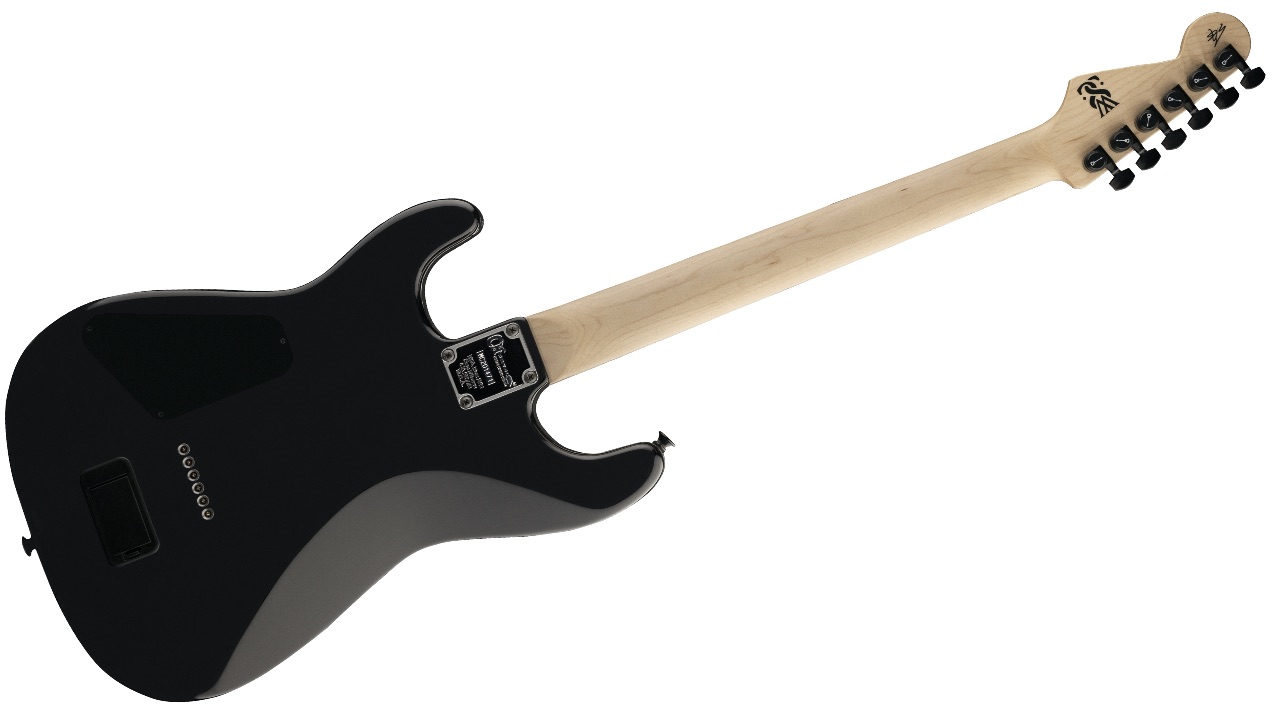
And you’ve got the locking tuners. Was there anything else you had to have on the guitar?
“The hard-tail, the pickups, and the gloss black. Everything, to be honest. But it had to be hard-tail. It had to be, no questions whatsoever. It had to be this shape. Had to be gloss black because I could not find a gloss-black Stratocaster anywhere that didn’t have something different about it that I didn’t like, either three pickups, or it would be the wood, or it would be matte black, or blue or whatever.
“And then I think I tried a design with rosewood [fingerboard] but then I tried that and I loved it. But yeah, everything was a must. I got rid of the tone knob. Maybe that’s another level of maturity that I will get to but, for me, it is either on or off. I don’t need it. It’s just not worth it. I’ve even had guitars with two on them and thought what are they even doing there?”
It is not an intimidating guitar. I know a few people who have bought it as their first guitar which is a good sign to me
And there’s no coil-split. How many positions on the selector?
“Three. It’s as no-bullshit as you can get really. It is not an intimidating guitar. I know a few people who have bought it as their first guitar which is a good sign to me.”
That is a very good first guitar.
“But you see here [points to three-pickup San Dimas on the wall] that middle pickup – and with the bar on it – to a beginner that might be intimidating. I wanted to make this as futuristic and simple as possible.”
What guitar amps are you playing through at the moment?
“Live, I’m playing through a [Peavey] 6505. Sometimes a 6534+.”
What difference do you hear?
“It is one of those things. We did some albums with the 6505 and then one day we did one with a 6534 just to change it up. Nothing that I could really pinpoint that it does differently; it’s just a head, almost like using a different pickup. I used the JVM205 Marshall for rockier riffs, octave riffs, and more of the punk side of things. But for riffy riffs it is always Peaveys.
“And my chain, I’m never a fan of post-gain, in terms of after my amp. I always try to get the best out of my pickup and the amp and then I don’t need to add anything more.
“Having said that, now I’ve been playing single-coils, I love the idea of going through an amp, then a bit of a boost and getting it right with a few things. And then I use octave pedals, reverb pedals, delay, my [Digitech] Whammy and my wah. I’m pretty basic.”
You’ve got an octave fuzz in there, too, right?
“It’s a [MXR] Slash model. It is incredible. I have used it for so long. But in terms of effects, I love a bit of reverb, delay for leads, and octave for some breakdowns, then standard rhythm, clean.”
The main food groups. And they’re quite old effects but they’re still quite radical sounding. The octave pedal is still bonkers after all these years.
“I don’t know how I have ended up there. Even the wah, I suppose, is a very vintage, classic effect as well.”
Where do you stand on compression and noise-gates, and those sort of hygiene items. There’s a tube amp humming in the background here.
“Yeah, that’s the thing! If we were filming today I thought I’ll need to bring a noise suppressor. Any high-gain amp, you need to noise-suppress it. But I love noise-suppressors, because they also round off that bottom end and it puts it in a nice neat package. They really lend themselves to making the riffs sound good. It’s not just about cutting the noise. They pump those edges.
“Compression? Maybe post, through a DAW, a little bit. But in terms of guitars, ‘Let’s compress the guitars!’ No, not really. Compress the fuck out of the bass! Maybe some leads, so that all the leads are kind of as one. But I only ever have a small compression on riffs.”
You’ll be running those tube amps hard so there will be a natural compression anyway.
“Absolutely, yeah. And the pickups have some compression in them. I like it. There are two sides of the coin; you can have it really dynamic but this is somewhere in the middle. And, especially for a beginner, it helps with a consistent tone. You play a riff and the pickup will help you. But then, like we were saying, you can dial the gain back and then it is up to you.”
This is when you know it’s a good instrument. When you are playing it you are not thinking about what you could change
Is that what the ambition, to get younger players to pick this up?
“Yeah, I want them to pick it up and it sounds amazing. I don’t want them to be struggling. This is when you know it’s a good instrument. When you are playing it you are not thinking about what you could change. There are no red flags.
“When I first picked this up, I played it, my mind is not saying anything; I am just playing the guitar. You’re not saying, ‘Oh, the volume knob is getting in the way, I need to lower the action, the intonation’s weird...’ nothing, which means it’s good. You get to play riffs and that’s it.”
- The Charvel Sean Long Signature Pro-Mod San Dimas Style 1 HH HT M is available now, priced $1,199, £1,069, €1,249. See Charvel for more details.
- While She Sleeps' Sleeps Society is out now via Spinefarm.
Jonathan Horsley has been writing about guitars and guitar culture since 2005, playing them since 1990, and regularly contributes to MusicRadar, Total Guitar and Guitar World. He uses Jazz III nylon picks, 10s during the week, 9s at the weekend, and shamefully still struggles with rhythm figure one of Van Halen’s Panama.
